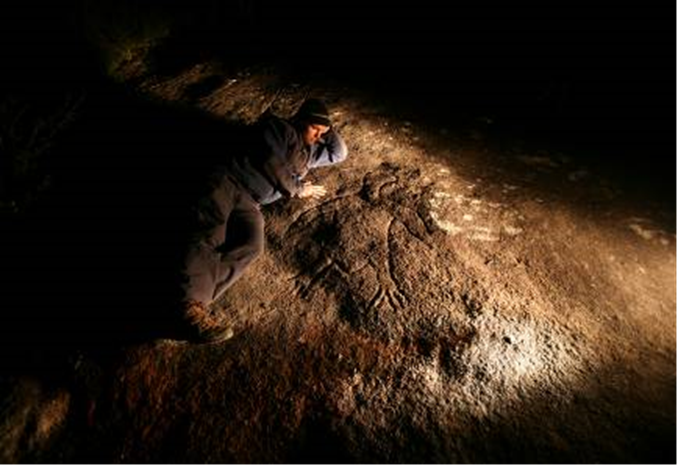This month in Archaeology: 2020-21 AMF/AMRI Visiting Research Fellow on the Rock Art Recovery Project
Wayne Brennan, a 2020-21 AMF/AMRI Visiting Research Fellow, discusses how scientists and Aboriginal communities work together on the Rock Art Recovery Project - two ways walking together side by side.
The impact of a wildfire on cultural features in the landscape can have disastrous results for the conservation of rock art. However, the subsequent clearing and recovery efforts from the fires, and opening up of country can assist survey teams in locating rock art sites. The Rock Art Recovery Project builds on work done in the early 2000s and is based on a holistic approach to rock art conservation, whereby the Aboriginal community and scientists work together to create a skilled team of rock art recorders and monitors. The skills and experience of the team are appropriate for assessing, recording, and monitoring pigment art and engravings. This approach of culture and science walking together side by side and assisting each other, is paramount to the project and could become a model for other groups in the Greater Blue Mountains World Heritage Area (GBMWHA) and the Sydney-Blue Mountains Region.

The main eagle depiction at Eagle’s Reach. For Aboriginal community members the fact that it appears to be holding artefacts indicates it is an extremely rare depiction of the Eagle Ancestor.
Image: Paul S.C. Taçon© Paul S.C. Taçon
From the beginning this has been a sharing project, with all aspects jointly managed and conducted by individuals in both the Aboriginal and archaeological communities. Conservation and recording techniques are shared and discussed with clearly identified and measurable outcomes supported by the communities. Presentations and publications are also jointly produced and authored. Strong friendships have developed as a result, not only between archaeologists and First Nations People, but also between people from different Aboriginal groups.
Graham Davis -King (Deerubin LALC) and Muliyan Waters (Wiradjari) long term partners in the Wollemi rock art project (2000 till the present), are also involved, being the Aboriginal community coordinators for this new project. Barry William (Darkinjung) will be the community coordinator for the Darkinjung LALC which will be working in the Wommera Range area of Parr Conservation Area.
The project aims to better understand the relationship between the cultural heritage, especially rock art sites (drawings, stencils, paintings, and engravings), of the Greater Blue Mountains World Heritage Area (GBMWHA) and that of other parts of New South Wales, and to describe culture changes over the past few thousand years. The project values contemporary Aboriginal viewpoints, involves extensive ongoing community consultation and participation and advocates for government, industry, and community approaches to research.

Matthew Kelleher next to a life-size eagle engraving, Gallery Rock.
Image: Tristram Miller© Tristram Miller
Areas of focus
Three sites have been identified as particularly at risk, and these will form the focus for the initial surveys. These sites include:
- Linden Ridge - urban interface and Blue Mts National Park
- Mt Irvine Mt Wilson Ridge - remote and urban interface
- Woomarah Range (Parr Conservation Area) - remote area
Managing viewpoints
As a rock art specialist, I tend to manage viewpoints rather than focus on the literal meaning or interpretation of the individual motifs or elements.
Aboriginal rock art connects people with country, lore, story and the ancestral creational beings of that country. Aboriginal people recognise that culture and spirit are important elements of a sustainable future. This project assists with passing down knowledge and recognises the importance of culture and ceremony.
This project’s major innovation relates to knowledge sharing. It recognises the real-world benefits of sharing expertise. It also allows local communities to take leadership roles in sustainable protection and promotion of “at risk” cultural features. This is particularly important in the Blue Mountains, a region that boasts a remarkable record of human presence dating back at least 40,000 years and faces a significant bushfire risk.
The approach
As I’ve mentioned, the approach of culture and science walking together side by side and assisting each other is an integral and unique part of the project. You may ask what I am referring to by cultural knowledge and scientific knowledge in the project?
Cultural knowledge is passed down through storytelling, song, dance, art, ceremonies, and rituals. This still occurs today.
In regard to the science side of this project, I am referring to mapping, physical site conservation and management, field skills and technical equipment (map reading, photography, site plans, historic and lithic artefact identification, data entry and recovery). Professional standards include cultural awareness, stakeholder engagement, legislation, and oral history collection.

Jacky Ward, Evan Yanna Muru Gallard and Wayne Brennan recording one of the recently discovered grinding grooves and engraving sites on the Wollemi travel route, September 2004.
Image: Paul S.C. Taçon© Paul S.C. Taçon

Roger Uluru Shannon sketching engravings highlighted with coloured wool, Gallery Rock.
Image: Paul S.C. Taçon© Paul S.C. Taçon
The project has begun with a series of “on country” workshops to engage with local custodians and discuss their participation in rock art conservation and protection. We aim to provide field experience and training for all attendees including Traditional Custodians and students – two ways walking together, side by side.
Wayne Brennan
Gamilaraay and Blue Mountains Community
2020-21 AMF/AMRI Visiting Research Fellow

